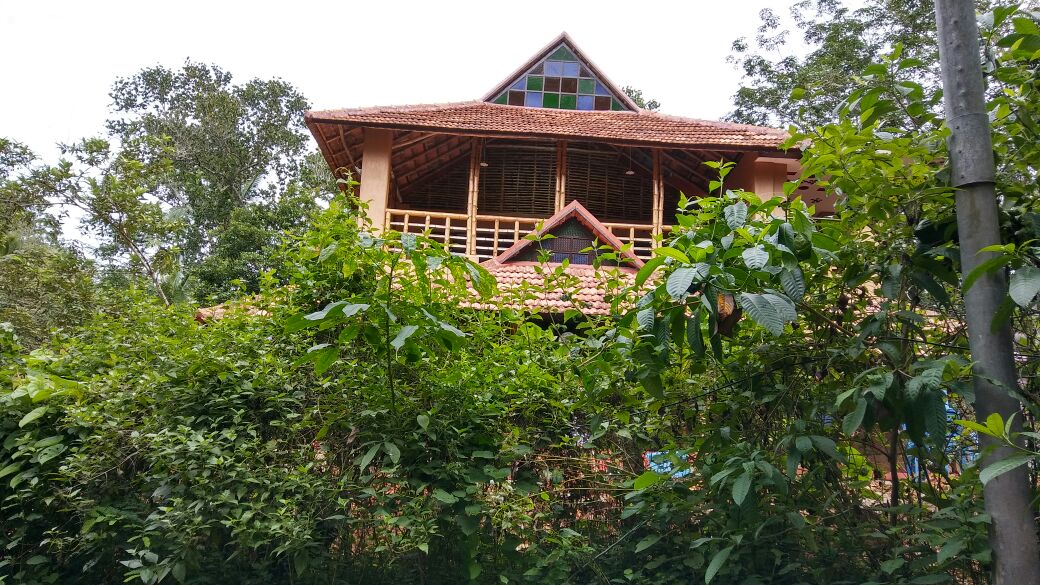Sridhar Radhakrishnan (51), an engineer by profession and environmentalist by passion, was sure that he did not want to live in the house that he had inherited from his parents. “The building was located in one of Trivandrum’s busiest areas, and I wanted some peace of mind and devoid of air and noise pollution. So I started looking for a place that would give my lungs fresh air and less noise,” he informs The Better India.
Interestingly, he did not want to build a new home considering the emissions from all the construction work. He looked for several options but to no avail.
Want to make your home eco-friendly? Check out these cost-effective and 100% natural handcrafted accessories for your home and kitchen!
Finally, he found an empty 21 cent plot on the outskirts of the city in Valiyavila nestled among the rubber estates.

“I loved the plot so much that I decided to construct a house, but without compromising on my environmental ideals. I was deeply inspired by Laurie Baker and his principles of sustainable architecture, and wondered if my home could also be built keeping those in mind,” he quips.
He roped in PB Sajan, an architect at the Centre of Science and Technology for Rural Development to translate his dream into reality. His brief to the architect was clear—to make a house from recycled materials and if destroyed, can be recycled.
Luckily for Sridhar, Sajan complied, and after ten months of construction, Sridhar, his wife, Sobha and son Ambareesh, moved into their new home, a two-story mud home christened ‘Vasantham,’ in July 2017.
How Recycled Materials Built A Recyclable Home
Sridhar believes that constructing an eco-friendly home is very feasible and comes with innumerable benefits. “Today, there are so many architects, agencies, experts available to shape your home without harming the environment. All you need is a will and some trips to places where you can find recycled materials,” he explains.
Here are some of the techniques that Sajan and his team followed, while building Vasantham.
1) The home was built using the mud-lime mortar technique from the soil or mud of the land. Lime was added to the construction process to make soil durable like cement.
2) “Mani Bhavan, a stately home was being demolished to pave the way for a high-rise. So, I purchased 30,000 waste bricks and roof tiles from the builder. The bathroom tiles were also produced from a sanitary ware shop that was shutting down,” explains Sridhar.
3) Instead of using the chemical paints, the walls in the home were plastered with a concoction of mud and rice husk. This gives an old-charm feel of Kerala-style traditional homes.
4) The wood used to make steps and lampshades are second-hand. The two roofs (on the ground floor and first floor), have also been constructed from second-hand tiles.
5) The parapet and the first-floor roofs were made from bamboo, and bamboo poles were used as pillars to support the ceilings. The bamboo used was purchased from a tribal community.
6) Open verandahs, large windows and rooms and a huge balcony for the first floor, allows natural air and light inside the home.
7) All the electrical appliances like geyser, induction cooker, fans and lights in the home are energy-efficient.
Due to its peculiar design, Sridhar claims that even during the hottest months of the year, the temperature inside the home is almost 10 degrees lower. “It the same during winters as well. It is such a blessing to have the desired temperature without having to use heaters or ACs,” says Sobha.
Sridhar has also created bunds inside the premises to ensure that rainwater collected on ground and rooftop is not wasted. For their water uses, the family has a borewell, and the rainwater collected, seeps into the ground, thus recharging the groundwater tables as well.
The couple also grow their vegetables using organic methods. “These are for our consumption. We use organic compost and pest repellants and even compost from wet garbage generated in the house,” says Sridhar. Excess vegetables is sold to the Organic Bazaar that runs in the city.
In a world where cement is the go to material for every construction that takes place, Sridhar and Sobha’s house sets an example of how we can go back to our green traditional methods while having a modern touch.
All the images are sourced from Sridhar Radhakrishnan. You can reach him at sridharthanal@gmail.com
Also Read: Chennai Architect Reuses Waste, Uses Mud & Timber to Build Green Homes!
(Edited by Gayatri Mishra)
Like this story? Or have something to share?
Write to us: contact@thebetterindia.com
Connect with us on Facebook and Twitter.
We bring stories straight from the heart of India, to inspire millions and create a wave of impact. Our positive movement is growing bigger everyday, and we would love for you to join it.
Please contribute whatever you can, every little penny helps our team in bringing you more stories that support dreams and spread hope.

